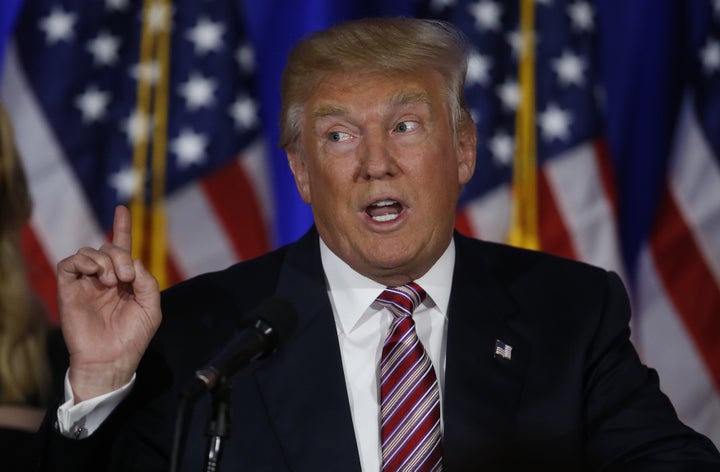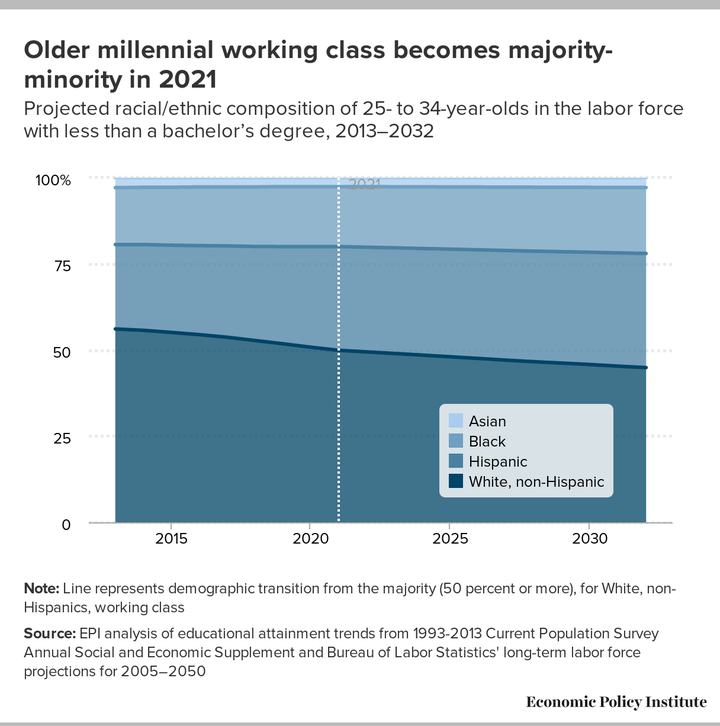
The American working class is becoming a lot less white, a new analysis reveals -- yet more evidence that the racist underpinnings of Donald Trump's campaign are not just morally abhorrent but, frankly, illogical.
By 2032 a majority of the working class, defined as employed adults with less than a bachelor’s degree, will be people of color, according to projections based on labor department data that the Economic Policy Institute released Thursday. The change will come faster for younger working people. In just five years, people of color -- including Hispanics, Asian- and African-Americans -- will make up a majority of working-class adults ages 18-27.
Today, people of color represent about 39 percent of the working class, according to EPI.
In explaining Donald Trump’s rise to political prominence, writers for The New York Times, The Washington Post and other outlets have said that his biggest strand of support comes from angry working-class Americans fed up with an economy that is leaving them behind. Trump promises to bring back lost jobs from overseas and to somehow renegotiate trade deals that disadvantage American workers.
But the reality TV star's unabashed use of racism in his campaign is alienating a huge swath of working people and pitting lower-income Americans against each other.
“Trump is missing a large chunk of working class Americans,” Valerie Wilson, the EPI economist who authored the report, told The Huffington Post. “The strategy he is using is divisive. It makes it difficult for people to see how similar they are in terms of economic interest.”
In other words, Trump's rhetoric hurts the very group he purports to want to rescue.

A good part of Trump’s appeal is aimed straight at the working class, which has suffered for decades as the underpinnings of the U.S. economy have transformed from the manufacturing to the service sector. Factory jobs have vanished and more and more people with high school and associate degrees are landing at Walmart or other lower-paying service sector jobs.
But Trump is also fueling the despair of the working class by fanning the flames of racial resentment. He has actually called Mexican immigrants rapists and criminals; suggested that a judge’s race or ethnicity prevents him from issuing fair rulings; proposed the U.S., which was founded on the core principle of religious freedom, actually ban an entire religious group from entering the country. He’s also made bizarre comments calling one rally attendee “my African-American.”
The voting data itself casts doubt on how much Trump actually appeals to the working classes. According to primary voting data analyzed by Nate Silver, Trump voters are in a higher income bracket.
Trump's working class appeal is really just a white working-class appeal, George Packer writes in the New Yorker.
But that appeal is straight-up misguided as, increasingly, the interests of the white working class are not really different from the interests of the African-American or Hispanic working class, Wilson's report notes.

Regardless of race, the working class' biggest problem right now is wage stagnation. Pay is not going up for them -- even as the incomes of the country’s top earners continue to soar.
For policy makers to truly address this rising income inequality, they’ll need to grapple with racial inequality, too.
“The two become more closely linked as this demographic transition gets closer,” Wilson said.
For example, black and Hispanic workers make less money per hour than their white counterparts. If this wage discrimination continues, Wilson said, that could mean yet more downward wage pressure for the working class.
The only real solution would be for the entire group to come together to marshall its political power to change things, Wilson said.
Wilson points to the success of the Fight for $15, the groups organizing for a hike in the minimum wage to $15 an hour. “Things are happening.”
Notably, Trump has been wishy-washy on supporting a minimum wage increase -- despite saying he wants to improve prospects for working Americans.
It's extremely unlikely that, a full year into his campaign, Trump is alienating nearly half of his supposed base simply out of ignorance. Instead, his tactics appear much more sinister and familiar: Pitting working-class Americans against each other, using race, instead of making progress on policies that could actually help them: Raising the minimum wage, creating a nationwide family leave law and offering better child care for working parents.
“The divisive politics is really a smokescreen to really addressing the issues at hand,” Wilson said. “It plays on people’s biases instead of addressing economic issues head-on.”
Editor’s note: Donald Trump regularly incites political violence and is a serial liar, rampant xenophobe, racist, misogynist and birther who has repeatedly pledged to ban all Muslims — 1.6 billion members of an entire religion — from entering the U.S.
